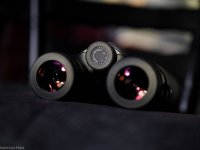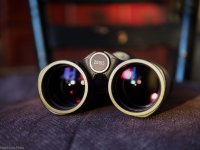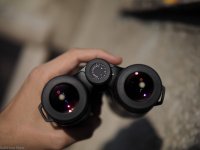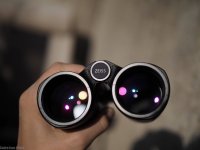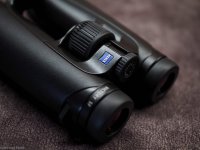dorubird
The unskilled mechanic blames his tools!

I had the opportunity to compare Zeiss SF 10x42 (new black version) vs Swaovski EL Swarovision 10x42 (current version).
Here are the differences observed after a first comparison that lasted about 1 hour:
Optical differences
The resolution on the center was higher at SF. I tested it on a chart resolution with binoculars on tripod. I expected it to be better at Swaro because it has better contrast, but it didn't happen that way. Zeiss had a better definition. But on the edges Swaro is better with 100% FOV clarity. Zeiss only about 95%.
The impression of brightness was similar in both binoculars. But due to the Swaro bluer shade and a much closer colours to the reality, Swarovski white rendering seemed to be brighter than SF, which has a pale green hue. But the slightly lower contrast at SF seemed to make the shaded areas a little brighter than Swaro. So in conclusion the general impression was that the brightness was similar in both instruments.
Chromatic aberrations were similar with a slight edge advantage for SF. But I am talking here about almost invisible chromatic aberrations, both instruments behaving exemplary.
Glare resistance. I saw a very weak circular reflection at the bottom of the image with Swaro. It wasn't intrusive, but I saw this circular reflection only at the Swaro.
Construction differences
The ergonomics of SF are clearly superior, the balance of the binoculars being extraordinary. Both binoculars weigh 800g but SF seems much lighter. The focus is impeccable on SF, very uniform and silky. Instead, I think that at Swarovski I came across a bad specimen because it had a focus with a very inconsistent movement (with small leaks and differences in friction). The finish and design of Swarovski is much more carefully chosen, giving the impression of a price object, fitting more as a clothing accessory. Zeiss has a simpler military look.
My conclusion
Even if it has a lower contrast than Swaro and a green-leaning color, for me Zeiss SF 10x42 looks much more relaxing and pleasing than the Swarovision EL 10x42. In front of SF eyepieces I was amazed by the immersive and relaxed image. In comparation Swarovski EL Swarovision it's a very well optically corrected binoculars but lacks SF "magic". Basically with SF I have the impression that I look through a large window which I hold in my hands, the binoculars magically disappearing! In addition, SF has even a more three-dimensional image.
sorry for my bad english!
Here are the differences observed after a first comparison that lasted about 1 hour:
Optical differences
The resolution on the center was higher at SF. I tested it on a chart resolution with binoculars on tripod. I expected it to be better at Swaro because it has better contrast, but it didn't happen that way. Zeiss had a better definition. But on the edges Swaro is better with 100% FOV clarity. Zeiss only about 95%.
The impression of brightness was similar in both binoculars. But due to the Swaro bluer shade and a much closer colours to the reality, Swarovski white rendering seemed to be brighter than SF, which has a pale green hue. But the slightly lower contrast at SF seemed to make the shaded areas a little brighter than Swaro. So in conclusion the general impression was that the brightness was similar in both instruments.
Chromatic aberrations were similar with a slight edge advantage for SF. But I am talking here about almost invisible chromatic aberrations, both instruments behaving exemplary.
Glare resistance. I saw a very weak circular reflection at the bottom of the image with Swaro. It wasn't intrusive, but I saw this circular reflection only at the Swaro.
Construction differences
The ergonomics of SF are clearly superior, the balance of the binoculars being extraordinary. Both binoculars weigh 800g but SF seems much lighter. The focus is impeccable on SF, very uniform and silky. Instead, I think that at Swarovski I came across a bad specimen because it had a focus with a very inconsistent movement (with small leaks and differences in friction). The finish and design of Swarovski is much more carefully chosen, giving the impression of a price object, fitting more as a clothing accessory. Zeiss has a simpler military look.
My conclusion
Even if it has a lower contrast than Swaro and a green-leaning color, for me Zeiss SF 10x42 looks much more relaxing and pleasing than the Swarovision EL 10x42. In front of SF eyepieces I was amazed by the immersive and relaxed image. In comparation Swarovski EL Swarovision it's a very well optically corrected binoculars but lacks SF "magic". Basically with SF I have the impression that I look through a large window which I hold in my hands, the binoculars magically disappearing! In addition, SF has even a more three-dimensional image.
sorry for my bad english!
Last edited:






